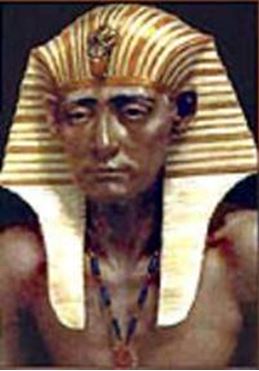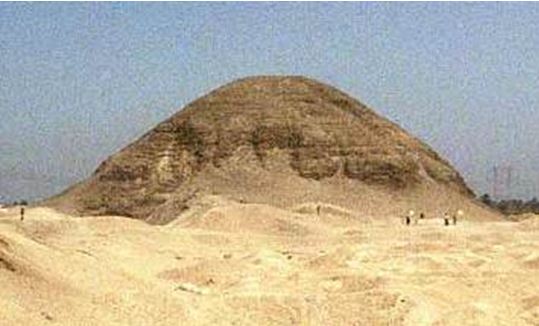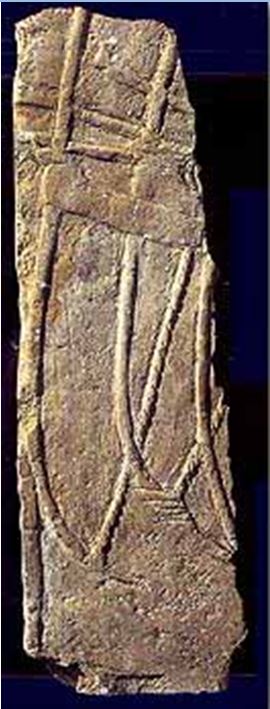Oahspe Study
The Exodus of the Hebrews, Moses and the Pharaohs Part 10
The Exodus Marks the End of the Egyptian Pyramidal Age

1550 b.c.e. marked the last of the pyramid age in Egypt. The reasons why the Pharaohs abandoned the cult of Osiris and at the same time stopped building large royal pyramids (associated with the cult of Osiris) are not explicit in historical accounts. Some historians attributed the change in religious cults to the victory over the Hyksos, but this is because the rise of Amun-Re as the supreme deity of the Egyptians took place immediately following the so called Expulsion of the Hyksos. This does not directly explain why the Osiris cult and the building of pyramids were abandoned, since there is no historical explanation of why the credit should go to Amun instead of Osiris.
A number of references in Oahspe indicate that the Pharaoh, Nu-ghan, was the one who abandoned the Osirian Religion, established the God King status of the Pharaohs (like that of the Old Kingdom), and built the last royal pyramid.
A direct reference to the end of the pyramid age is found in Moses' address to Nu-ghan hundreds of years later when Nu-ghan was released from hell:
Oahspe, God's Book of Eskra; 28/16.38.
|| Then Moses looked upon Pharaoh (Nu-ghan) and said: These things had to be, you were the last of the pyramidal age of man, and I the first founder of the migration of the righteous. All things are done by Jehovih, in His own way and time.||
At the time of Nu-ghan's reign as Pharaoh, it had not yet come to pass that there were no more pyramids constructed, and so, it is in retrospect that Nu-ghan is said to be "the last of the pyramidal age of man". The last royal pyramid is believed to have been built in Abydos, and has been attributed to Ahmose I around 1550 b.c.e. What is left of it today is no more than a wide-spread pile of rubble:
||.....significance [of Abydos] in Egyptian history cannot be questioned, and many mysteries surround this archaeological site. It was a holy site to the Egyptians, where some of the earliest rulers were probably buried, but it remained a focus of religious activity for thousands of years.
One such mystery surrounds the rubble core and casing stone that marks the remains of the last known royal pyramid built in Egypt by the founder of the New Kingdom, Ahmose.....|| (retrieved 28 Sept, 07.)
Location of Pyramids
The accounts regarding the so called 2nd Intermediate period do not describe clearly where the pharaohs resided, it is assumed by Egyptologists that they were situated in Thebes, and the Hyksos in Avaris. However, the Middle Kingdom pharaohs were believed to be based at Itjtawy just south of the Apex of the Nile delta and the Old Kingdom capital of Memphis. Egyptologists understand the majority of the pyramids as being part of funerary complexes situated significant distances from residences and palaces, but Oahspe describes the residence of the pharaoh who was Moses' adoptive father, as being within a large walled complex which included his pyramids:
Oahspe, Book of the Arc of Bon; 27/15.1, 3.
|| The king's palace and pyramids were surrounded by a wall of stone, with twelve gates, made of wood and iron. The wall was of sufficient breadth for twelve men to walk abreast on it, and the height of the wall was equivalent to 12 squares (32ft-Newbrough's footnote) On the summit of the wall were twelve houses for the accommodation of the soldiers who patrolled the walls. And in each and every gate-way were houses for the keepers of the gates. So that no man, or woman, or child, could come into the palace or palace grounds without permission.....||
This enclosure extended to the river, since Leatonas found the child among the rushes in the river, and the king said:
||......Keep the child, and it shall be both a brother and a son to you. Nevertheless, my guards shall find the way my grounds are entered, or blood will be upon them........||
The layout of the King's residence as described in Oahspe clarifies that the king resided near his pyramids and the whole of the area down to the river was walled with gates and guards. This should not be unique to this Pharaoh, but may have been a common practice, in the Middle Kingdom at least. A number of pyramids and associated buildings, usually believed to be temples by archaelogists had thick, high walls with gateways built around them, as described in Oahspe. The description below of Amenemhat III's pyramid complex also describes a wall that extends to the water, with a causeway connecting to the water. Also, Amenemhat III's pyramid was believed to be near his palace:
|
|
|
|
|
Amenemhat III's Pyramid at Hawara |
|| Hawara is located near the Fayum oasis, to the South, even, of Meidum, next to one of the channels connecting the Nile to the lake of the oasis. After having abandonned the plan to be buried at Dashur, the southern edge of the Memphite necropolis, Amenemhat III would chose this location, perhaps near to his palace, for his final interment.... The pyramid lay in the north of an elaborate complex enclosed by a wall measuring 385 by 158 metres. This makes the Hawara complex the largest Middle Kingdom funerary complex.
The entrance to the complex was located at the southern corner of the east wall. A causeway appears to have led up to it. Unfortunately, almost nothing remains of this vast complex which Greek and Roman visitors, many centuries after it was built, described as a vast labyrinth of open courts, chambers, chapels and hidden crypts. The Greek traveller Herodotos said it had 12 main courts and that the visitor was guided from courtyards into rooms into galleries into more rooms and from there into more courtyards.
An interesting comparison can be made between the layout of the Hawara complex and the complex of Netjerikhet at Saqqara. Both complexes are long rectangular structures oriented north-south. Both have their pyramid located in the north of the complex, be it that with Netjerikhet, there was also a court to the north of the pyramid. || (retrieved 4 Oct, 07)
Middle Kingdom Pyramids used Mud Brick
||.....In common with the Middle Kingdom pyramids constructed after Amenemhet II, it [Amenemhat III's pyramid] was built of mud-brick round a core of limestone passages and burial chambers, and faced with limestone. Most of the facing stone was later pillaged for use in other buildings -- a fate common to almost all of Egypt's pyramids -- and today the pyramid is little more than an eroded, vaguely pyramidal mountain of mud brick, and of the once magnificent mortuary temple precinct formerly enclosed by a wall there is little left beyond the foundation bed of compacted sand and chips and shards of limestone.....|| (retreived 4 Oct, 07)
It is significant that the remnants of Amenemhat's wall construction found at Hawarra indicate that the wall was made of limestone and not mud-brick, because mud bricks were used extensively in that period, and there are other sites where walls surrounding pyramids and temples (such as Abydos) are made of mud-brick. It is another detail that is in accord with the description in Oahspe.
Mud Brick Surrounding Walls of Earlier Complexes
||...[At Abydos, near Thebes] fortress-like sanctuaries enclosed by mud-brick walls [made of mud and sand]... The last and largest of the cult centers -- the only major one still standing in clearly recognizable form -- was erected for King Khasekhemwy, who ruled in the second dynasty around 2780 B.C. Known today as Shunet el-Zebib, the two-acre enclosure stands on a desert plain at Abydos, 300 miles south of Cairo near the burial grounds of early Egyptian rulers.....
British archaeologists investigating the site more than a century ago described the enclosures as fortresses, but more recent excavations, particularly at the one dedicated to Khasekhemwy, revealed the association with royal mortuary practices. Even so, owing to a dearth of inscriptions, archaeologists remain largely in the dark as to just what went on inside these centers to memorialize the king in afterlife....
The rulers were not buried at these sites. The underground royal tombs at Abydos are a mile south of the excavated enclosures. Later kings were buried elsewhere inside pyramids, which adjoined stone temples where priests made offerings and conducted rituals for the king. At Shunet el-Zebib, the pre-pyramid architecture represents a grandeur of purpose and an investment of time and labor signifying expanding royal power. High, thick double walls, more massive than for any previous mortuary complex, enclose a rectangular open space. Originally, the structure had four monumental gates and a whitewashed facade that glistened in the sun....
Some of the mud-brick walls still stood at close to their original height of 35 feet and thickness of 15 feet. An analysis of the ancient bricks revealed their original formula: two parts mud, one part sand mixed in water and sun-dried for two weeks.|| (retrieved 4 Oct, 07)
||....The ruins of Ahmose at Abydos are extensive, not only consisting of a pyramid and mortuary complex, but also the town of the workers who built and later managed the facilities.
The mortuary temple that is recognizable as such lies somewhat north of the pyramid. This structure appears for the most part to be the outer section of the temple, with a plan consisting of a massive wall on the east and a central doorway that lead to a forecourt. From the forecourt, a doorway leads to a square court. Foundation blocks at the back might have supported the pillars of a colonade. However, between this section of the temple and the pyramid itself are what probably remains of an inner court where little was found except patches of pavement and four circular granaries along the back wall. Mace also discovered a semi-circular mud-brick deposit that may have either been the remains of a ramp, or the inner sanctuary of the temple.
At the southeast corner of the pyramid, a second smaller temple was also discovered that was probably dedicated to Ahmose's sister-wife, Ahmose-Nefertari. The pyramid had a core built of sand and loose stone rubble, which, after having lost most of its outer casing, fell into ruin. Originally, it was probably some 52.5 meters (172 ft) square with a similar or slightly smaller height. Mace estimated, from the remains of two intact courses of casing stones that survived at the eastern base of the pyramid, that its slope measured about 60 degrees...|| (retrieved 30 Sept, 07)
The Last Royal Pyramid to be built in Egypt
Archaeological evidence of "the Last Pharaoh of the Pyramidal Age" was only discovered in 1899 and it was not until 1902 that the ruins were identified as Ahmose I's. But Oahspe identified the Pharaoh of the Exodus as "The Last of the Pyramidal Age" in 1882! Oahspe has consistently provided information unknown to mortal man at the time of its publication, the identification of the Exodus Pharaoh as the "Last of the Pyramidal Age" is just one instance.
Evidence of the last Pyramid discovered in 1899 identified as Ahmose in 1902
|| The remains of Ahmose's pyramid in Abydos were discovered in 1899 and identified as his in 1902. Most of its outer casing stones had been robbed for use in other building projects over the years, and the mound of rubble upon which it was built has collapsed..... || (retrieved 8 Sept, '13)
Oahspe, God's Book of Eskra; 28/16.38.27/15.1, 3.
|| Then Moses looked upon Pharaoh (Nu ghan) and said: These things had to be. You were the last of the pyramidal age of man, and I was the first founder of the migration of the righteous. All things are done by Jehovih, in His own way and time.||
Today, the last royal pyramid built in Egypt is no more than a pile of rubble and sand. Ahmose's ruined pyramid is significantly different to those of his predecessors of the Middle Kingdom. Ahmose had his built without any mud-bricks, it centre was filled with sand and rubble which lacked sufficient cohesion and strength to withstand the elements after the outside layer of stone was removed by later generations.
|
|
|
|
i) A remnant from the ruins of Ahmose's pyramid, depicting warrior exploits of the King.
|
ii) Site plan of Ahmose I pyramid and temple |
The construction of the last pyramid of Egypt also confirmed that Ahmose I was Nu-ghan. It follows that having lost his Hebrew slave population in his first reigning year, he had no slaves to make the many mud-bricks required to build the pyramids as his predecessors had done, and it stands to reason that he felt compelled to organise some semblance of a labor force to maintain his kingdom. Evidently, after attempting to round up sufficient slaves, and taking by force and subduing any who would not pay tribute in slaves, he carried on to build his pyramid with a reduced and inexperienced labor force. And so was the beginning of a line of warrior pharaohs of the New Kingdom, who kept their kingdoms supplied by conquest of their neighbors, taking slaves as booty.
|| The autobiography of Ahmose, son of Ebana 18th dynasty: Ahmose, son of Ebana, was an officer in the Egyptian army during the end of the 17th Dynasty to the beginning of the 18th Dynasty.|...Then Avaris was despoiled, and I brought spoil from there: one man, three women; total, four persons. His majesty gave them to me as slaves. Then Sharuhen was besieged for three years. His majesty despoiled it and I brought spoil from it: two women and a hand.... His majesty carried him [the rebel Aata] off as a living captive, and all his people as booty.|| (retrieved 5 Oct, 07)
The last royal pyramid of Egypt has been attributed to Ahmose I, but knowing that he was Nu-ghan, Pharaoh of the Exodus, it is a wonder he was even able to build any pyramids at all. Perhaps after various campaigns to subdue any rebellious nomarchs and subsidiary kingdoms, he may have acquired sufficient slaves to build an "inferior" pyramid which required less labor.
Besides the question of how a pyramid could have been built without a large slave force, remains the question of what precipitated the abandonment of the cult of Osiris after the Exodus of the Hebrews.
||.... of all the pyramids built in Egypt, that of Ahmose at Abydos is one of the most intriguing. It signals the end of the Pyramid age and to some extent, a changing of the guards in funerary practices. The earliest pyramids were focused on the sun god, Re, but even prior to Ahmose, the mythology surrounding the funerary god, Osiris, was being incorporated into the substructures of the later pyramids. By building his complex at Abydos, Ahmose certainly intended to associate his mortuary cult more directly with Osiris. After Ahmose, the kings of Egypt would, for the most part, completely abandon the pyramid structure.|| (retrieved 5 Oct, 07)
The two cults of Osiris and Amun-Re appear side by side in Ahmose I's reign. It appears that the form of the pyramid was not abandoned by Ahmose, at the time the cult of Amun-Re was adopted. Neither was it ignored when the site for the Valley of the Kings was chosen by his son, Amenhotep I, since the Valley of the Kings is overlooked by the Pyramid Mountain. As characteristic in Egyptian Religions, the emerging cult inherits characteristics of the passing cult and reforms them to the new style. Thus we find that the newest God of the Egyptian religion, Baal, is now restyled as Amun-Re, a war god, inspirer of Ahmose I.
The fall of the Osiris cult and the establishment of Amun-Re as the dominant God of Egypt with references to Oahspe and historical contexts are addressed in Parts 11 and 12.
All Oahspe references are from the Standard Edition Oahspe of 2007
● GO
TO NEXT ARTICLE
THE EXODUS PART 11-- The End of the Osiris Cult



